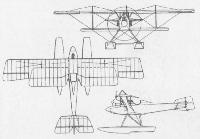
Описание
Страна: Германия
Год: 1917
Fighter
O.Thetford, P.Gray German Aircraft of the First World War (Putnam)
Sablatnig SF 4
Ordered on 17th July 1916, the SF 4 was not delivered until 17th February 1917. Only the single example of this single-seat seaplane station defence fighter was built. No. 900. A triplane version was also constructed, No. 901. Engine, 150 h.p. Benz III. Span, 120 m. (39 ft. 4 1/2 in.). Length, 8.33 m. (27 ft. 4 in.). Height, 3.73 m. (12 ft. 2 7/8 in.). Area, 28.26 sq.m. (300 sq.ft.). Weights: Empty, 798 kg. (1,756 lb.). Loaded, 1,078 kg. (2,372 lb.). Speed, 158 km.hr. (98.75 m.p.h.). Climb, 1,000 m. (3,280 ft.) in 5.5 min., 2,000 m. (6,560 ft.) in 14 min. Armament, one Spandau machine-gun forward. N.B. The triplane variant spanned 9.25 m. (30 ft. 4 1/8 in.) and was 28.38 sq.m. (306 sq.ft.) in area.
Описание:
- O.Thetford, P.Gray German Aircraft of the First World War (Putnam)
- W.Green, G.Swanborough The Complete Book of Fighters
- J.Herris German Seaplane Fighters of WWI (A Centennial Perspective on Great War Airplanes 2)
- J.Herris German Seaplanes of WWI (A Centennial Perspective on Great War Airplanes 15)
Фотографии
-
J.Herris - German Seaplanes of WWI /Centennial Perspective/ (15)
The sole Sablatnig SF4 biplane prototype was Marine Number 900.
-
J.Herris - German Seaplane Fighters of WWI /Centennial Perspective/ (2)
Elegant appearance belied the poor manoeuvrability displayed by the SF 4 biplane.
-
J.Herris - German Seaplanes of WWI /Centennial Perspective/ (15)
The SF4 biplane prototype photographed in the snow; the broad interplane struts may have helped streamlining but obstructed the pilot's field of view to the sides.
-
J.Herris - German Seaplane Fighters of WWI /Centennial Perspective/ (2)
The SF4 biplane prototype is photographed in the snow; the broad interplane struts may have helped streamlining but obstructed the pilot's field of view to the sides.
-
J.Herris - German Seaplanes of WWI /Centennial Perspective/ (15)
Triplanes were even tried for floatplane fighters; SF4 Marine #901 was developed from the SF4 #900 biplane. There was no improvement in performance.
The SF4 triplane carried Marine #901 and had ailerons on all wings. Little information is available on the triplane SF4, but it was not selected for production. -
J.Herris - German Seaplane Fighters of WWI /Centennial Perspective/ (2)
The SF4 triplane carried Marine #901 and had ailerons on all wings. Little information is available on the triplane SF4, but it was not selected for production.
-
J.Herris - German Seaplanes of WWI /Centennial Perspective/ (15)
Apparently the performance of the SF4 triplane was no improvement over the SF4 biplane and, like the biplane, only one was built.
-
W.Green, G.Swanborough - The Complete Book of Fighters
Only one prototype of the SF 4 was completed in biplane configuration.
-
J.Herris - German Seaplanes of WWI /Centennial Perspective/ (15)
Sablatnig SF4 SVK Drawing










